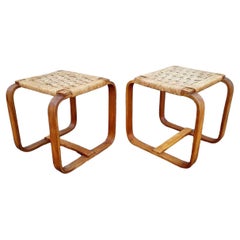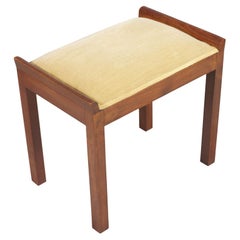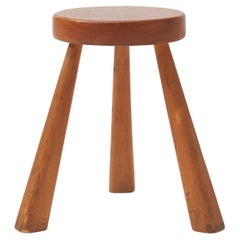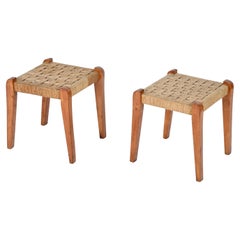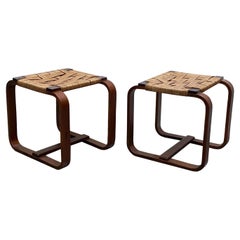Giuseppe Pagano Pogatschnig Stools
An accomplished architect, exhibition designer, furniture maker and magazine editor, Giuseppe Pagano Pogatschnig helped direct Italy’s rationalist architectural movement until his death near the end of World War II. Wounded twice and captured twice in World War I, Pogatschnig left military service to work as the editor and director of Casabella architecture magazine and went on to design the V Milan Triennale and VI Milan Triennale alongside fellow Italian architect Gio Ponti.
Originally born in the Austro-Hungarian Empire, now modern-day Croatia, Pogatschnig studied Italian in Trieste before joining the Italian army to serve in the First World War. After that harrowing and traumatic experience, he became a founding member of the first Fascist Party in Parenzo. In 1924, he graduated from Turin Polytechnic with an architecture degree and began designing bridges, pavilions and buildings, including the Gualino office complex, in Turin. Nearing 1928, Pogatschnig began work on pavilions for the Turin International Exhibition.
Pogatschnig’s involvement in the V and VI Milan Triennales stand today as some of his greatest contributions to Italian architecture. He held full control over the design of the latter exhibition, in 1936, which led to the opportunity to design many of the interiors of the Italian Pavilion at the Paris Expo the following year.
Pogatschnig’s reputation as an architect and designer were overshadowed only by his outspoken nature as an editor. By 1942, he openly criticized the Italian regime and left the Fascist Party to join the resistance a year later. These activities led to his capture, imprisonment and escape from Brescia in 1944. Ultimately, Pogatschnig was recaptured, tortured and transferred across prisons to Austria’s Mauthausen concentration camp, where he died on April 22, 1945, less than a month before the end of fighting in Europe.
On 1stDibs, find vintage Giuseppe Pagano Pogatschnig seating, tables, and case pieces.
1930s Italian Art Deco Vintage Giuseppe Pagano Pogatschnig Stools
Rope, Plywood
1920s French Art Deco Vintage Giuseppe Pagano Pogatschnig Stools
Walnut
1960s French Mid-Century Modern Vintage Giuseppe Pagano Pogatschnig Stools
Pine
Mid-20th Century Giuseppe Pagano Pogatschnig Stools
Wood
Mid-20th Century Italian Mid-Century Modern Giuseppe Pagano Pogatschnig Stools
Ash
Mid-20th Century Italian Mid-Century Modern Giuseppe Pagano Pogatschnig Stools
Steel
1930s French Mid-Century Modern Vintage Giuseppe Pagano Pogatschnig Stools
Oak
1970s Italian Mid-Century Modern Vintage Giuseppe Pagano Pogatschnig Stools
Wood
1940s Italian Mid-Century Modern Vintage Giuseppe Pagano Pogatschnig Stools
Rattan, Beech
1930s Italian Mid-Century Modern Vintage Giuseppe Pagano Pogatschnig Stools
Rope, Plywood
Early 20th Century Italian Art Deco Giuseppe Pagano Pogatschnig Stools
Leather, Walnut
Mid-20th Century Italian Mid-Century Modern Giuseppe Pagano Pogatschnig Stools
Rope, Beech, Bentwood
1940s Modern Vintage Giuseppe Pagano Pogatschnig Stools
Rope, Wood
1940s Italian Mid-Century Modern Vintage Giuseppe Pagano Pogatschnig Stools
Rope, Wood, Beech
1940s Italian Mid-Century Modern Vintage Giuseppe Pagano Pogatschnig Stools
Wood
1940s Italian Mid-Century Modern Vintage Giuseppe Pagano Pogatschnig Stools
Wood
1840s Italian Mid-Century Modern Antique Giuseppe Pagano Pogatschnig Stools
Rope, Wood
1930s Italian Mid-Century Modern Vintage Giuseppe Pagano Pogatschnig Stools
Papercord, Plywood
1930s Italian Mid-Century Modern Vintage Giuseppe Pagano Pogatschnig Stools
Cord, Paper, Plywood
